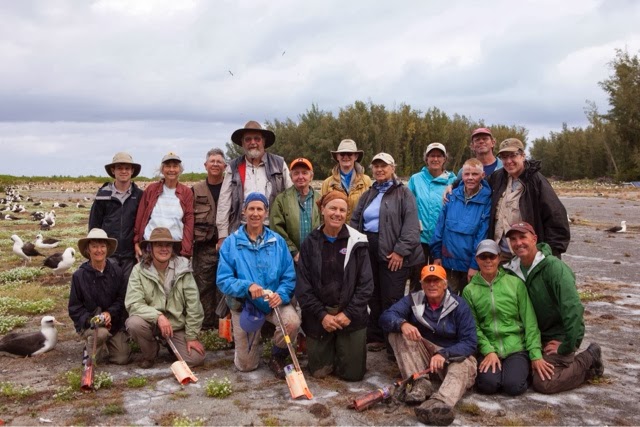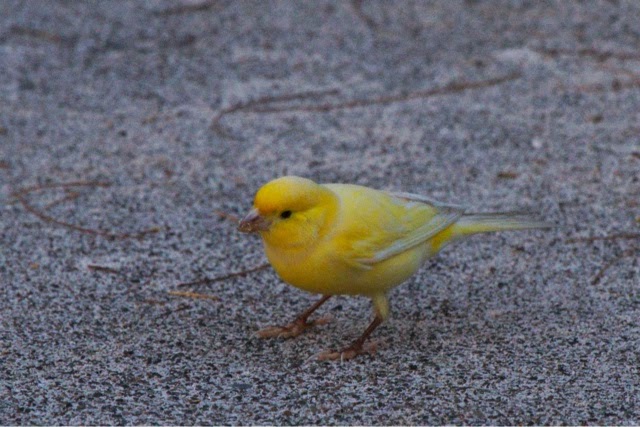It has taken much work and funding to bring back the birds. With the introduction of man to the island came critters such as rats and rabbits. All birds, even seabirds, since they nest on the islands, are extremely vulnerable to the introduction of invasive animal and plant species. So it was huge when rats were removed from Midway in 1997!!
We break into 3 teams with 6 people. Each team has 1-2 team leaders. Everyone is issued a bike upon arrival and is the main mode of transportation.

Our fearless Team Leaders: Jill, Richard, Jenny, Martha & Breck

Each team had to come up with a name. Our team was "Noddy & Nice" - Shirley, Richard, Bob, Bettina, Jenny & David
Noddy & Nice on Eastern Island taking a break
Here is the whole gang!! What a great group of folks:)
About half way through the count a special team referred to as the "Burrow Team" is formed by the lightest folks with the most experience at avoiding falling into burrows and skilled at repairing the burrows if they do happen to fall into one.
The photo below gives you and idea of the density of burrows. Each little depression in between the albatross nests is a burrow. Some are shallow and some can be very deep. When Bob would step in a deep one he would be up to his thigh!! You must think light:)
Below are photos of Bonin Petrels hanging out and digging their burrow. What a huge success story the comeback of the petrels and shearwaters is. Since the eradication of the rats the birds have slowly been coming back to the island to nest. Now the Bonin Petrel numbers are in the hundreds of thousands. When they start coming back to their burrows/nests at dusk the sky is literally filled with petrels! What a lovely sight!
Busy digging a burrow!

The Burrow Team!
 |
One of the bonuses of counting near the beach besides being near the beach is that you sometimes find glass balls. I found my first glass ball and it was a biggie!
David found his on Eastern Island.
 The islands are divided into sectors with the exception of Spit Island. Spit Island is is so small it makes up only one sector.
The islands are divided into sectors with the exception of Spit Island. Spit Island is is so small it makes up only one sector.
The view of the beach on Eastern Island- Paradise!
The islands are pretty much naturally open and flat with the exception of some of the areas that the military builtup for armament or fortification. Ironwood trees were planted originally for wind breaks and have spread across much of the sandy coastal area. There is also napaka along the sandy beaches- some areas are thicker than others with a fair bit of heliotrope as well. The sandy open areas are filled with Bonin Petrel & Wedge-tailed Shearwater burrow holes. Most of the island beaches are closed due to being protected for monk seals and green sea turtle habitat.
Our counting tools consisted of a paint gun, fluorescent orange paint to mark the nests and 2 counters to keep track of Laysan & Black-footed nests.
In the morning we all meet at the "paint shed" and each team gets their assignment for the day. We then ride our bikes to the designated sector. We begin by form a line and move across the sector very slowly marking each albatross nest with a dot of paint and making a click on the appropriate counter (Laysan or Black-footed)
We finished the count a day and a half early so we had an opportunity to volunteer for other activities for Fish & Wildlife. We did some bunchgrass planting in a newly cleared area. The area had previously had marine barracks located there. They were removed last year due to hazardous materials. The bunch grass will serve to minimize erosion and provide habitat for the birds. Here is our team.
This is where we slept- Charlie Barracks. As you can see we are surrounding by albatross nests. It is so fun to go to sleep and wake up to the sound of the birds.

This is where we ate- the Clipper House. Thai cooks prepare three meals a day for all of the staff and volunteers on island. The food is amazing- especially Christmas and New Year's Day Feasts.
A beautiful sunrise with the Midway House on the right. The Midway House is where the military commander and his family lived in the Navy days. Currently the Refuge Manager lives there. It is a beautiful house.
Cool fact-Jenny Johnson (one of our Leaders) spent a few memorable years living on Midway as a child. Her father was Harbor Master. Now she and her husband run the count here on Midway:-)
When we aren't counting albatross nests there is so much to do:
We had an informal Christmas Bird Count on Christmas Day. The photos below are a few of the birds we saw.
Canaries thrive here.
Northern Pintails swimming around in a seep.

Wandering Tattler
Bristle-thighed Curlews could be seen perching on branches and tree stumps calling.

Pacific Golden Plover were seen all around the island.
A Peregrine Falcon we saw on last year's Christmas Bird Count.
What a wonderful place to make new friends

When the temperature was warm enough we loved to swim on this beautiful beach. The sand was like powdered sugar and the water was so soft. We would play in the waves with the albatross and boobies flying over our heads.

Given the chance we were off exploring and taking photos.
Male Adult Great Frigate Bird
Green Sea Turtle

Black Noddy on the nest in an Ironwood Tree
Adult Brown Booby
Brown Noddy in the Napaka
Short-tailed Albatross on Sand Island
Look how much bigger the Short-tailed is than the Black-footed Albatross
Black-footed Albatross doing the courtship dance
Black-footed Albatross- what a beautiful being
We saw this young Monk Seal right off the pier on Eastern Island last year

Turtlebeach- look at those huge turtles!
Brown Booby on Eastern Island
Green Sea Turtle at Finger Piers
Hybrid Laysan-Black-footed Albatross in the foreground ( a beautiful silver breast)
Laysan Albatross at much deserved rest
Laysan Albatross coming in for a landing
Leaving on a jet plane back to Honolulu
Turtle and Hawk












































